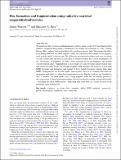Files in this item
Disc formation and fragmentation using radiative non-ideal magnetohydrodynamics
Item metadata
| dc.contributor.author | Wurster, J. | |
| dc.contributor.author | Bate, Matthew R. | |
| dc.date.accessioned | 2019-10-25T10:30:03Z | |
| dc.date.available | 2019-10-25T10:30:03Z | |
| dc.date.issued | 2019-06 | |
| dc.identifier | 262150069 | |
| dc.identifier | 73945391-99f8-41f8-a7e7-243655bf674e | |
| dc.identifier | 85067995621 | |
| dc.identifier.citation | Wurster , J & Bate , M R 2019 , ' Disc formation and fragmentation using radiative non-ideal magnetohydrodynamics ' , Monthly Notices of the Royal Astronomical Society , vol. 486 , no. 2 , pp. 2587-2603 . https://doi.org/10.1093/mnras/stz1023 | en |
| dc.identifier.issn | 0035-8711 | |
| dc.identifier.other | Bibtex: WursterBate2019 | |
| dc.identifier.other | ORCID: /0000-0003-0688-5332/work/63716928 | |
| dc.identifier.uri | https://hdl.handle.net/10023/18767 | |
| dc.description.abstract | We investigate the formation and fragmentation of discs using a suite of 3D smoothed particle radiative magnetohydrodynamics simulations. Our models are initialized as 1 M⊙ rotating Bonnor–Ebert spheres that are threaded with a uniform magnetic field. We examine the effect of including ideal and non-ideal magnetic fields, the orientation and strength of the magnetic field, and the initial rotational rate. We follow the gravitational collapse and early evolution of each system until the final classification of the protostellar disc can be determined. Of our 105 models, 41 fragment, 21 form a spiral structure but do not fragment, and another 12 form smooth discs. Fragmentation is more likely to occur for faster initial rotation rates and weaker magnetic fields. For stronger magnetic field strengths, the inclusion of non-ideal MHD promotes disc formation, and several of these models fragment, whereas their ideal MHD counterparts do not. For the models that fragment, there is no correlation between our parameters and where or when the fragmentation occurs. Bipolar outflows are launched in only 17 models, and these models have strong magnetic fields that are initially parallel to the rotation axis. Counter-rotating envelopes form in four slowly rotating, strong-field models – including one ideal MHD model – indicating they form only in a small fraction of the parameter space investigated. | |
| dc.format.extent | 17 | |
| dc.format.extent | 2364744 | |
| dc.language.iso | eng | |
| dc.relation.ispartof | Monthly Notices of the Royal Astronomical Society | en |
| dc.subject | Accretion: accretion discs | en |
| dc.subject | Magnetic fields | en |
| dc.subject | MHD | en |
| dc.subject | Methods: numerical | en |
| dc.subject | Planets and satellites: formation | en |
| dc.subject | Stars: formation | en |
| dc.subject | QB Astronomy | en |
| dc.subject | QC Physics | en |
| dc.subject | DAS | en |
| dc.subject.lcc | QB | en |
| dc.subject.lcc | QC | en |
| dc.title | Disc formation and fragmentation using radiative non-ideal magnetohydrodynamics | en |
| dc.type | Journal article | en |
| dc.contributor.institution | University of St Andrews. School of Physics and Astronomy | en |
| dc.identifier.doi | 10.1093/mnras/stz1023 | |
| dc.description.status | Peer reviewed | en |
| dc.identifier.url | https://arxiv.org/abs/1904.07263 | en |
This item appears in the following Collection(s)
Items in the St Andrews Research Repository are protected by copyright, with all rights reserved, unless otherwise indicated.

